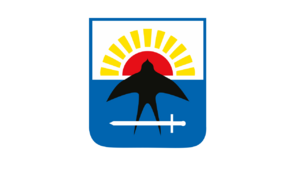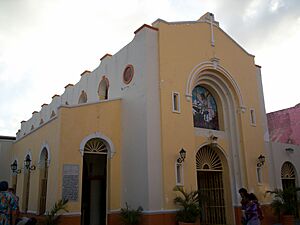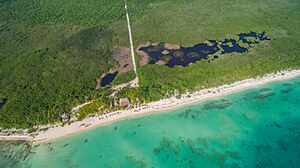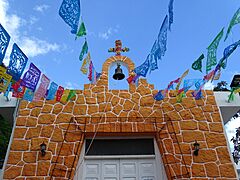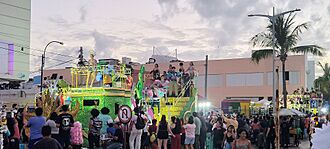Cozumel facts for kids

Satellite image of Cozumel Island in 2001
|
|

Location of Cozumel in Quintana Roo State
|
|
| Lua error in Module:Location_map at line 416: Malformed coordinates value. | |
| Geography | |
|---|---|
| Location | Caribbean Sea |
| Coordinates | Lua error in Module:Coordinates at line 614: attempt to index field 'wikibase' (a nil value). |
| Total islands | 2 |
| Area | 647.33 km2 (249.94 sq mi) |
| Highest point | 14 m |
| Administration | |
|
Mexico
|
|
| State | Quintana Roo |
| Municipality | Cozumel |
| Largest settlement | San Miguel de Cozumel (pop. 84 915) |
| Presidente municipal (Municipal president) | Juanita Obdulia Alonso Marrufo (Morena) |
| Demographics | |
| Population | 88 626 (2020) |
| Pop. density | 154.5 /km2 (400.2 /sq mi) |
| Ethnic groups | Mestizo, Maya, White Mexicans, Afro-Mexicans |
| Additional information | |
| Time zone | |
| Official website | cozumel.gob.mx |
| Official name: Parque Nacional Arrecifes de Cozumel | |
| Designated: | February 2, 2005 |
| Reference #: | 1449 |
| Official name: Manglares y Humedales del Norte de Isla Cozumel | |
| Designated: | February 2, 2009 |
| Reference #: | 1921 |
Cozumel (pronounced kosuˈmel) is a beautiful island in the Caribbean Sea. It is located off the eastern coast of Mexico's Yucatán Peninsula. The island is part of the Mexican state of Quintana Roo. It is separated from the mainland by a channel.
Contents
What Does Cozumel Mean?
The name Cozumel comes from the Mayan word "Cuzamil." This word means "the island of swallows."
Where is Cozumel Located?
Island Size and Population
Cozumel is in the Caribbean Sea, about 82 kilometers (51 miles) south of Cancún. It is also about 19 kilometers (12 miles) from the mainland. The island is about 48 kilometers (30 miles) long and 16 kilometers (10 miles) wide. Its total area is about 478 square kilometers (185 square miles).
Cozumel is Mexico's largest Caribbean island. It is also the largest island in Mexico that is always inhabited. The population of Cozumel was 88,626 people in 2020. Most people live in the town of San Miguel de Cozumel, which had 84,915 residents in 2020.
Cozumel's Piers
Cozumel has five main piers. Three of these piers are for large cruise ships. A ferry pier in San Miguel is used for passenger ferries that travel to and from Playa del Carmen. Another pier south of downtown is only for vehicle ferries.
Island Landscape
Much of Cozumel is covered with mangrove forests. These forests are home to many unique animal species. Cozumel is a flat island made of limestone. This means it has a special type of landscape called karst topography. The highest point on the island is less than 15 meters (49 feet) above sea level.
Cozumel also has many cenotes. These are water-filled sinkholes formed over thousands of years. Water slowly goes through the soft limestone soil to create them. There are 18 deep cenotes and over 250 shallow ones on the island. Many are hidden by thick plants.
What Animals Live on Cozumel?
Cozumel is home to many special animals. Some of these animals are found only on this island.
Unique Birds
- the Cozumel emerald (a type of hummingbird)
- the Cozumel great curassow (a large bird, now vulnerable)
- the Cozumel thrasher (a bird that might be extinct)
- the Cozumel vireo
- the Cozumel wren
Unique Mammals
Some small mammals on Cozumel are smaller than their relatives on the mainland. This is called Insular dwarfism.
- the Cozumel fox (which might be extinct)
- the Cozumel Island coati (a type of raccoon, now endangered)
- the Cozumel Island raccoon (critically endangered)
Other rodents on Cozumel are larger than their mainland relatives. This is called Island gigantism.
- Oryzomys couesi
- Peromyscus leucopus
- Reithrodontomys spectabilis (critically endangered and found only here)
Unique Marine Life
- the splendid toadfish (a colorful fish found only in Cozumel's waters)
Other Wildlife
Other animals that live here include:
- the American crocodile
- the black spiny-tailed iguana
- the blue land crab
Some animals that are not native to the island have also been introduced, like the boa constrictor.
What Does the Cozumel Flag Mean?
The Cozumel flag shows a swallow on a blue and white background. The blue color stands for the sea. The white color represents the purity of the Mayans. The sun shows that the island is in the eastern part of Mexico. The swallow reminds us of the meaning of Cozumel in the Mayan language. The sword on the flag is Spanish. It represents when the Spanish arrived on the island in 1521.
Cozumel's Amazing Coral Reefs
Cozumel is famous for its beautiful coral reefs. These reefs are home to over 1,000 different kinds of marine animals. The reefs are mostly found on underwater cliffs. Some are also in coastal lagoons.
These reefs are part of the huge Mesoamerican Barrier Reef System. This is the second largest reef system in the world. It stretches over 1,000 kilometers (620 miles). Cozumel's deeper reefs used to have a lot of black corals. However, these corals have decreased over time.
Protecting the Reefs
A large part of the reef on the south side of the island is a protected area. It is called the Arrecifes de Cozumel National Park. This park is protected by an international agreement called the Ramsar Convention. It is also part of a UNESCO protected area called the Isla Cozumel Biosphere Reserve.
The reefs in Cozumel have both hard coral and soft coral. Many marine animals live there, including sponges, crabs, snails, starfish, and many kinds of Caribbean fish. The park is also a home for endangered marine species. These include the loggerhead sea turtle, hawksbill sea turtle, and the unique splendid toadfish.
Scuba Diving in Cozumel
Because of its rich marine life and clear, warm waters, Cozumel is one of the best places in the world for scuba diving. The coral reefs on the western shore are protected by the island's natural shape.
In 1996, the Mexican government created the Cozumel Reefs National Marine Park. This park makes it illegal to touch or remove any marine life. This helps protect the reefs.
Even with these protections, some things have caused damage. A large pier was built for cruise ships in the 1990s. This caused some harm to the reefs. Over the past few decades, the health of Cozumel's coral reefs has declined. There is less coral cover now than there used to be.
To help the reefs recover, the Marine Park of Cozumel started closing reefs periodically in 2019. They close a different reef every two months. This allows the reefs to rest and heal. The reefs are showing positive signs of recovery.
What is Cozumel's Climate Like?
Cozumel has a tropical savanna climate. This means it is warm all year round. It has a short dry season from February to April. Even then, it still gets some rain. The wet season is longer, covering most of the year. September and October are the wettest months.
Temperatures stay pretty steady throughout the year. It is a bit cooler from December to February. January is the coolest month. The island is also quite humid because it is close to the sea.
| Month | Jan | Feb | Mar | Apr | May | Jun | Jul | Aug | Sep | Oct | Nov | Dec | Year |
|---|---|---|---|---|---|---|---|---|---|---|---|---|---|
| Record high °C (°F) | 36.4 (97.5) |
36.0 (96.8) |
34.7 (94.5) |
39.0 (102.2) |
36.6 (97.9) |
36.4 (97.5) |
39.2 (102.6) |
36.8 (98.2) |
36.6 (97.9) |
36.1 (97.0) |
35.2 (95.4) |
32.6 (90.7) |
39.2 (102.6) |
| Mean daily maximum °C (°F) | 28.6 (83.5) |
29.1 (84.4) |
30.9 (87.6) |
32.0 (89.6) |
32.7 (90.9) |
32.4 (90.3) |
32.6 (90.7) |
33.0 (91.4) |
31.9 (89.4) |
30.7 (87.3) |
29.7 (85.5) |
28.6 (83.5) |
31.0 (87.8) |
| Daily mean °C (°F) | 22.9 (73.2) |
23.2 (73.8) |
24.7 (76.5) |
26.0 (78.8) |
26.9 (80.4) |
27.2 (81.0) |
27.2 (81.0) |
27.2 (81.0) |
26.7 (80.1) |
25.9 (78.6) |
24.8 (76.6) |
23.4 (74.1) |
25.5 (77.9) |
| Mean daily minimum °C (°F) | 19.4 (66.9) |
19.4 (66.9) |
20.7 (69.3) |
21.8 (71.2) |
22.9 (73.2) |
23.8 (74.8) |
23.5 (74.3) |
23.5 (74.3) |
23.6 (74.5) |
23.1 (73.6) |
21.7 (71.1) |
20.3 (68.5) |
22.0 (71.6) |
| Record low °C (°F) | 9.2 (48.6) |
9.7 (49.5) |
11.4 (52.5) |
14.6 (58.3) |
15.2 (59.4) |
18.8 (65.8) |
17.0 (62.6) |
20.8 (69.4) |
20.8 (69.4) |
17.0 (62.6) |
11.2 (52.2) |
12.7 (54.9) |
9.2 (48.6) |
| Average precipitation mm (inches) | 81.4 (3.20) |
60.0 (2.36) |
32.2 (1.27) |
44.8 (1.76) |
110.6 (4.35) |
191.7 (7.55) |
115.5 (4.55) |
141.7 (5.58) |
240.2 (9.46) |
242.5 (9.55) |
122.5 (4.82) |
106.8 (4.20) |
1,489.9 (58.66) |
| Average precipitation days (≥ 0.1 mm) | 8.66 | 6.46 | 4.03 | 3.73 | 7.20 | 12.63 | 11.83 | 13.37 | 15.43 | 15.70 | 11.06 | 9.76 | 119.86 |
| Average relative humidity (%) | 82 | 81 | 79 | 79 | 80 | 84 | 84 | 84 | 87 | 85 | 83 | 83 | 83 |
| Mean monthly sunshine hours | 198.0 | 192.3 | 232.0 | 257.0 | 231.9 | 206.5 | 220.1 | 221.7 | 181.5 | 193.7 | 183.9 | 192.2 | 2,510.8 |
| Source: Colegio de Postgraduados | |||||||||||||
Cozumel's History
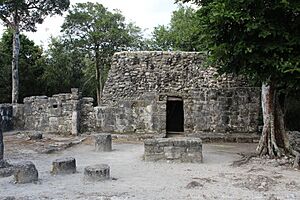
People believe the Maya first settled Cozumel around 1 AD. Even older artifacts from the Preclassic Olmec people have been found there. The island was a special, sacred place for Ixchel. She was the Mayan Moon Goddess of fertility.
In Mayan culture, all women had to visit the island at least once. They would go to worship Ixchel. She was the wife of Itzamna, the supreme Mayan lord of the skies. Women would ask Ixchel for fertility and happy motherhood. Archaeologists still find small dolls that were used in these rituals.
Ancient Ruins
Many ancient ruins can be found on the island. Most of them are from a later Mayan period. The largest Mayan ruins on the island were once near the main town. However, they have now been destroyed. Today, the biggest remaining ruins are at San Gervasio. These ruins are located near the center of the island.
European Arrival
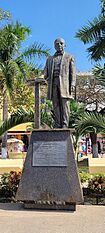
The first Spanish explorers visited Cozumel in 1518. This expedition was led by Juan de Grijalva. The next year, Hernán Cortés stopped at the island on his way to Veracruz. The Maya people of Cozumel welcomed both expeditions peacefully. This was different from how the Spanish were treated on other parts of the mainland.
Even after Cortés destroyed some Mayan statues and put up a picture of the Virgin Mary, the islanders helped the Spanish. They gave them food and water for their ships. This allowed the Spanish to continue their journeys. A captive of the Mayans, Gerónimo de Aguilar, was also rescued at this time.
Population Decline and Recovery
About 10,000 Maya lived on the island in the early 1500s. But in 1520, sick crew members from another Spanish expedition brought smallpox to the island. By 1570, only 186 men and 172 women were left alive.
In the years that followed, pirates often attacked Cozumel. In 1650, many islanders were forced to move to the mainland to escape the pirates. Later, in 1688, most of the remaining people on the island moved inland.
In 1848, people escaping a conflict called the Caste War of Yucatán settled on the island. In 1849, the town of San Miguel de Cozumel was officially recognized by the Mexican government.
Modern Cozumel
Work on the first Cozumel airport began during World War II. It was used for emergencies and by the Mexican military. Later, it was used for domestic flights. The current Cozumel International Airport was built in the late 1970s. It was made bigger in 1999.
Cozumel was hit directly by two strong hurricanes in 2005. In July, Hurricane Emily passed just south of the island. Then, in October, the larger and stronger Hurricane Wilma caused a lot of damage. Wilma was a Category 5 hurricane with very strong winds. Its eye passed directly over Cozumel.
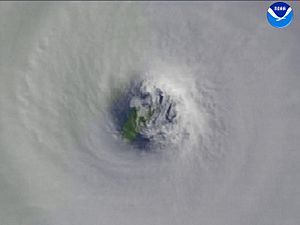
The storm damaged the underwater marine habitat. This included the coral reefs and the fish that live there. Trees, power lines, and cell phone towers were blown down. Cars were overturned, and piers were washed away. Roads collapsed, and new rivers appeared.
What is Cozumel's Economy Like?
Cozumel's economy mostly depends on tourism. Many people visit the island every day from cruise ships. Tourists also come for scuba diving, snorkeling, and fishing trips. There is some concern about how tourism affects Cozumel's natural environment.
Besides restaurants, hotels, and dive shops, vendors near the ports sell souvenirs and jewelry. All of these businesses help Cozumel's economy.
Fun Activities in Cozumel
Other water activities include para-sailing and kitesurfing. There is also a tourist submarine. Cozumel has two places where you can swim with dolphins. The only working pearl farm in the Caribbean is on the north side of the island.
San Miguel de Cozumel, the main town, has many restaurants with different types of food. It also has nightclubs, bars, cinemas, and outdoor stages. The main plaza is surrounded by shops. In the middle of the plaza, there is a stage where locals and tourists celebrate with music and dancing every Sunday evening.
All food and manufactured goods are brought to the island by ship. Water is provided by three different facilities that make fresh water from seawater.
Education in Cozumel
Cozumel has three universities. One is a public university called the University of Quintana Roo (UQROO). There are also two private universities. These schools offer different study programs. They include natural resources research, tourism, and business systems. The Cozumel Arts University also offers art education.
Cozumel's Culture and Festivals
Santa Cruz Festival and El Cedral Fair
The Festival of Santa Cruz and El Cedral Fair is a very old tradition. It takes place in the town of El Cedral in southern Cozumel. This annual event started over 150 years ago. It was begun by Casimiro Cárdenas.
Cárdenas was one of a group of people who escaped to the island. They fled from a village on the mainland after an attack in 1848. The attackers killed many villagers, but Cárdenas survived. He was holding a small wooden cross.
Legend says that Cárdenas promised to start a yearly festival wherever he settled. This was to honor the power of the crucifix. Today, the original Holy Cross (Santa Cruz) Festival is part of the larger El Cedral Fair. This fair includes traditional feasts, rodeos, bullfights, music, and competitions. The celebrations last about five days. They are held every year in late April or early May.
Cozumel Carnival
The Cozumel Carnival is one of the most important carnival celebrations in Mexico. It has been a tradition since the late 1800s. The carnival fills Cozumel's streets with parades. It starts the week before Mardi-Gras in February.
Cozumel's Carnival is a tradition passed down through many generations. It celebrates a mix of cultures that found a home in Cozumel. It began in the mid-1800s with young people dressed in colorful costumes. They were known as "Estudiantinas" or "Comparsas." They expressed themselves through dance, song, and fantasy in the streets of Cozumel.


